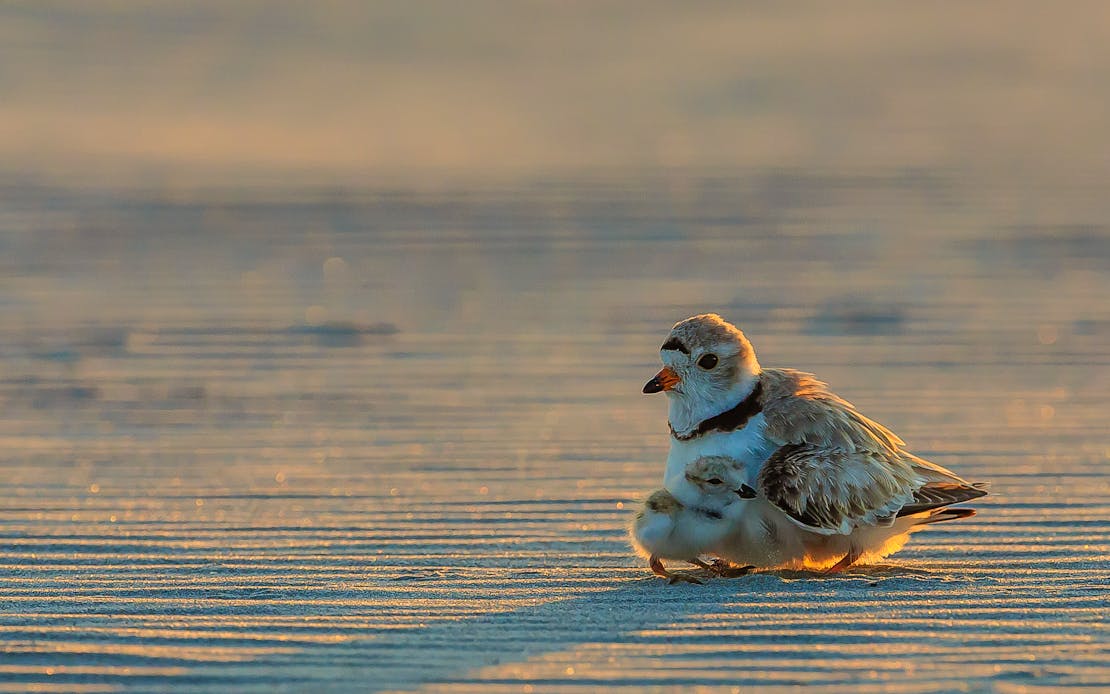Last week, Defenders of Wildlife published a ground-breaking study in the prestigious journal Nature Climate Change in which we found that 99.8% of endangered animals listed on the Endangered Species Act (ESA) are sensitive to climate change. Yet despite widespread evidence of climate change as a threat to biodiversity, government agencies are not adequately addressing this threat to species. Agencies tasked with protecting and restoring endangered species only considered climate change a threat to 64% of endangered animals, and planned management actions addressed climate change for only 18% of animals.
What does this mean for our nation’s most imperiled wildlife?
One species within that 18% with planned management action that address climate change is the piping plover. These shorebirds nest on beaches and coasts, where they are threatened by flooding, sea-level rise and incursion from invasive species. The species’ 2009 five-year review is an example of an ESA document that effectively lays out this emerging threat and recommending actions to stabilize beaches and to better understand long-term impacts.
But the majority of planning documents for climate-sensitive species lack that level of attention. For instance, California condors, once at the very edge of extinction but now on a path to recovery, are highly threatened by lead and other contaminants, whose toxicity could increase with warmer temperatures. The U.S. Fish and Wildlife Service (FWS) merely recommends studying the effects of climate change on the condor but has not yet planned management action.
Red-cockaded woodpeckers require old-growth longleaf pine, a rare, highly specific habitat that is sensitive to severe events like hurricanes. FWS has not published any ESA documents for these birds since 2006 and none of the existing documents discuss climate change.
The Everglades snail kite is sensitive to drought in the wetlands where they forage, and in 2017, Hurricane Irma destroyed every single one of the 44 active snail kite nests on Lake Okeechobee. FWS has not considered climate change in ESA documents for this species.
Florida grasshopper sparrows are found in only a handful of populations and are sensitive to the timing and amount of water in their marshy nesting habitats. Yet the sparrow lacks any consideration of climate change in its management documents.
Key deer, restricted to the Florida Keys that are disappearing with rising seas, only receive management direction of “more study” of the climate threat.
The Hawaiian stilt lives in coastal wetlands and mudflats that are sensitive to sea-level rise, but the 2012 recovery plan describes this issue as “beyond the scope of management.”
Many endemic Hawaiian bird species, like the small Kauai thrush and the Oahu elepaio, which are at risk as warming allows mosquitoes carrying deadly avian malaria to survive at higher elevations, shrinking the safe zones for the birds, have outdated plans that don’t discuss climate change.
Attwater’s prairie-chickens, which live only in a narrow band of remnant prairie along the Texas coast, are now restricted to two small populations. In 2017, Hurricane Harvey killed 24 of the 29 hens that were being tracked at the Attwater Prairie Chicken National Wildlife Refuge, as well as 80 percent of the birds in the only other wild population. The bird’s 2010 recovery plan does not mention climate change.
Golden-cheeked warblers inhabit small, fragmented habitats that are patchily distributed and sensitive to fire. The most recent recovery document, a 2014 five-year review, states that “All possible impacts from climate change cannot presently be predicted.”
Our study shows that while climate change is a pressing threat to imperiled species, the agencies that manage species protected by the Endangered Species Act have not given enough attention to this threat. Even worse, we found the agencies are moving in the wrong direction, with recent plans less likely to address climate change than they were a few years ago. The results of this new research highlight the gap between the widespread sensitivity of species to climate change and the insufficient attention from federal agencies charged with conserving endangered species.
Federal agencies must recognize the threat of climate change to our most imperiled animals and plan for how to mitigate and adapt to the threat. In addition to setting the nation on a path towards a lower-emissions future, Congress should:
- fully fund endangered species protection and recovery;
- ensure that agencies are planning for climate change and not taking actions that further imperil species; and
- support conservation efforts on both public and private lands to protect and connect key habitats for species persistence and movement.
As the U.S. develops new laws and policies to address climate change and allocates conservation funding, it is essential that steps are taken to protect our most imperiled species from the perils of climate change.
If you’d like to dive deeper into the data, please visit our free, interactive web application containing data and results from the study, developed and hosted by the Center for Conservation Innovation at Defenders of Wildlife.














Follow Defenders of Wildlife
facebook bluesky twitter instagram youtube tiktok threads linkedin